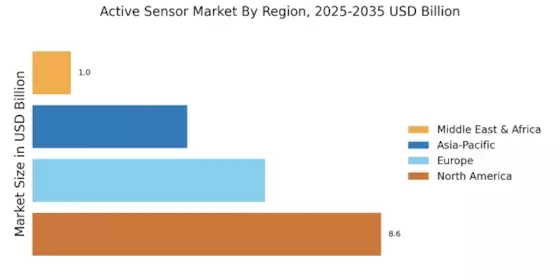Growing Emphasis on Environmental Monitoring
The Active Sensor Market is increasingly driven by the growing emphasis on environmental monitoring and sustainability. Active sensors are essential for tracking air and water quality, as well as monitoring climate change effects. With heightened awareness of environmental issues, industries are adopting active sensors to comply with regulations and improve sustainability practices. For example, active sensors are used in agriculture to monitor soil conditions and optimize water usage, contributing to more sustainable farming practices. This trend is likely to enhance the Active Sensor Market, with market analysts predicting a significant increase in demand for environmental monitoring solutions over the next few years.
Increased Investment in Smart Infrastructure
The Active Sensor Market is benefiting from increased investment in smart infrastructure initiatives. Governments and private entities are focusing on developing smart cities, which incorporate active sensors for traffic management, environmental monitoring, and public safety. These sensors provide real-time data that can enhance urban living conditions and optimize resource management. For instance, smart traffic systems utilize active sensors to monitor vehicle flow and reduce congestion, thereby improving air quality. As urbanization continues to rise, the demand for smart infrastructure is expected to grow, potentially leading to a market expansion for active sensors, with forecasts indicating a growth trajectory of around 12% annually.
Rising Demand for Automation in Various Sectors
The Active Sensor Market is significantly influenced by the rising demand for automation across various sectors, including manufacturing, automotive, and agriculture. Automation technologies rely heavily on active sensors to enhance operational efficiency and accuracy. For example, in manufacturing, active sensors are utilized for real-time monitoring and quality control, which can lead to reduced operational costs and increased productivity. The automotive sector is also witnessing a shift towards autonomous vehicles, where active sensors play a crucial role in navigation and safety systems. This growing trend is likely to drive the Active Sensor Market, with estimates suggesting a market value exceeding 30 billion dollars by 2026.
Technological Advancements in Sensor Technology
The Active Sensor Market is experiencing a surge in technological advancements, particularly in sensor technology. Innovations such as miniaturization, enhanced sensitivity, and improved data processing capabilities are driving the demand for active sensors. For instance, the integration of artificial intelligence and machine learning algorithms into sensor systems is enabling more accurate data collection and analysis. This trend is expected to propel the market, with projections indicating a compound annual growth rate of approximately 10% over the next five years. As industries increasingly adopt these advanced sensors for applications ranging from automotive to healthcare, the Active Sensor Market is poised for substantial growth.
Expansion of the Automotive Sector and Smart Vehicles
The Active Sensor Market is significantly impacted by the expansion of the automotive sector, particularly with the rise of smart vehicles. Active sensors are integral to advanced driver-assistance systems (ADAS), which enhance vehicle safety and performance. Features such as adaptive cruise control, lane-keeping assistance, and collision avoidance systems rely on active sensors for accurate data acquisition. As consumer preferences shift towards vehicles equipped with these technologies, the demand for active sensors is expected to rise. Market forecasts suggest that the automotive segment could account for a substantial portion of the Active Sensor Market, with growth rates potentially reaching 15% annually as smart vehicle adoption increases.

















Leave a Comment